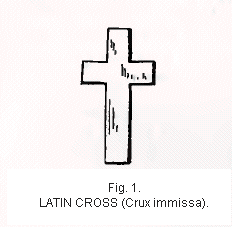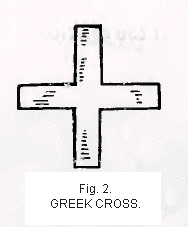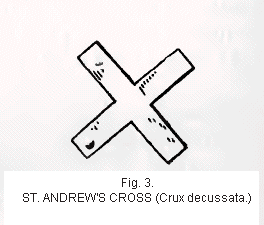|
The Swastika
Definitions, Description & Origin
Page 2
Quotations have been freely
made, instead of sifting the evidence and giving the substance. The justification
is that there has never been any sufficient marshaling of the evidence
on the subject, and that the former deductions have been inconclusive;
therefore, quotations of authors are given in their own words, to the
end that the philosophers who propose to deal with the origin, meaning
and cause of migration of the Swastika will have all the evidence before
them.
Assumptions may appear
as to antiquity, origin, and migration of the Swastika, but it is explained
that many times these only reflect the opinion of the writers who are
quoted, or are put forth as working hypotheses.
The indulgence of the
reader is asked, and it is hoped that he will endeavor to harmonize conflicting
statements upon these disputed questions rather than antagonize them.
I. Definitions, Description,
and Origin.
DIFFERENT FORMS OF THE CROSS.
The
simple cross made with two sticks or marks belongs to prehistoric times.
Its first appearance among men is lost in antiquity. One may theorize
as to it's origin, but there is no historical identification of it either
in epoch or by country or people. The sign is itself so simple that it
might have originated among any people, however primitive, and in any
age, however remote. The meaning given to the earliest cross is equally
unknown. Everything concerning its beginning is in the realm of speculation.
But a differentiation grew up in early times among nations by which certain
forms of the cross have been known under certain names and with specific
significations. Some of these, such as the Maltese cross, are historic
and can be well identified.
The principal forms of
the cross, known as symbols or ornaments, can be reduced to a few classes,
though when combined with heraldry its use extends to 385 varieties (1).
It is not the purpose
of this paper to give a history of the cross, but the principal forms
are shown by way of introduction to a study of the Swastika.
The Latin cross, Crux
immissa, (fig.1)  is
found on coins, medals, and ornaments anteriour to the Christian era.
It was on this cross that Christ is said to have been crucified, and thus
it became accepted as the Christian cross. is
found on coins, medals, and ornaments anteriour to the Christian era.
It was on this cross that Christ is said to have been crucified, and thus
it became accepted as the Christian cross.
The Greek cross (fig.2)
with arms of equal length crossing at right angles, is found on Assyrian
and Persian monuments and tablets, Greek coins and statues.
The St. Andrew's cross,
Crux decussata, (fig.3) is the same as the Greek cross, but turned
to stand on two legs.
 
ENDNOTES:
¹William Berry, Encyclopaedia Heraldica, 1825-1840 [Back]
<< Previous Page
Next
Page >>
© 2004-2007 Northvegr.
Most of the material on this site is in the public domain. However, many people have worked very hard to bring these texts to you so if you do use the work, we would appreciate it if you could give credit to both the Northvegr site and to the individuals who worked to bring you these texts. A small number of texts are copyrighted and cannot be used without the author's permission. Any text that is copyrighted will have a clear notation of such on the main index page for that text. Inquiries
can be sent to info@northvegr.org.
Northvegr™ and the Northvegr symbol are trademarks and service marks
of the Northvegr Foundation.
|
> Northvegr™ Foundation
>> About Northvegr Foundation
>> What's New
>> Contact Info
>> Link to Us
>> E-mail Updates
>> Links
>> Mailing Lists
>> Statement of Purpose
>> Socio-Political Stance
>> Donate
> The Vík - Online Store
>> More Norse Merchandise
> Advertise With Us
> Heithni
>> Books & Articles
>> Trúlög
>> Sögumál
>>
Heithinn Date Calculator
>> Recommended Reading
>>
The 30 Northern Virtues
> Recommended Heithinn Faith Organizations
>> Alfaleith.org
> NESP
>> Transcribe Texts
>> Translate Texts
>> HTML Coding
>> PDF Construction
> N. European Studies
>> Texts
>> Texts in PDF Format
>> NESP Reviews
>> Germanic Sources
>> Roman Scandinavia
>> Maps
> Language Resources
>> Zoëga Old Icelandic Dict.
>> Cleasby-Vigfusson Dictionary
>> Sweet's Old Icelandic Primer
>> Old Icelandic Grammar
>> Holy Language Lexicon
>> Old English Lexicon
>> Gothic Grammar Project
>> Old English Project
>> Language Resources
> Northern Family
>> Northern Fairy Tales
>> Norse-ery Rhymes
>>
Children's Books/Links
>> Tafl
>> Northern Recipes
>> Kubb
> Other Sections
>> The Holy Fylfot
>> Tradition Roots

Please Visit Our Sponsors
- Référencement
- Alfaleith.org - Heithni, Viðartrú
- Odin's Journey
- Baman - Iceland/Aboriginal Australia
- Biker's Booty
- Création site Internet Paris
- Pagan T-shirts
- Appartements
- Chalets au Québec
- Logo Designers
- Web Design
- Appartements Montreal
- Espace Bureau Montreal
- London Tours
- Spanish Property Legal Advice
- Multi Pret Hypotheque
- Company Logo Design
- Wiccan T-shirts
- Art Gallery, Painting artists
- free logo design reviews
- Heathen, Heathenism, Norse Pagan
- Logo design by LogoBee
- Pagan Shirts
- Norse Pagan Religion
- Triumph, BSA, Norton, Euro Motorcycles - Accessories
- Logo Maker
- Logo Design - Business Logos, Inc.
- Logo Design - Logo Maker
- Create A Website
- Wiccan Shirts
- Mortgages
- Multi-Prêts Hypothèques
- Viking T-shirts
- Hewlett Packard Ink Cartridges
- Indian Recipes
- Logo Design London
- Logo Design
- Logo Design UK
- Subvention et financement PME
- Heathen T-shirts
- Medical Alert, Emergency response
- orlando hotels
- Slot Machines for Vikings
- Norse Pagan Clothing and Merchandise
- New Homes
- Branding Irons
- Bachelor Degree Online
- Online Degree
- College Degree
- Heathen, Viking and Norse Texts
- Création site Internet
- Montreal Web Design
- Free Dish Network Satellite TV
- Discount ink cartridge & laser cartridge
- DUI Lawyers & DWI Attorneys
- Promotional Products
- Ready-Made Company Logos
- Canadian Art Dealer
- Best CD Rates
- Laser Toner Cartridge
- Logotyper & Grafiska Profilprogram
- Banner Design
- Custom Logo Design
Web site design and coding by Golden Boar Creations
|
|


 is
found on coins, medals, and ornaments anteriour to the Christian era.
It was on this cross that Christ is said to have been crucified, and thus
it became accepted as the Christian cross.
is
found on coins, medals, and ornaments anteriour to the Christian era.
It was on this cross that Christ is said to have been crucified, and thus
it became accepted as the Christian cross.

